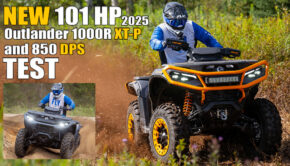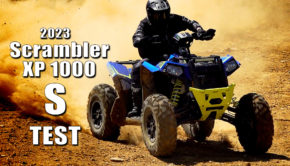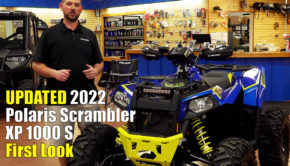Published on February 5th, 2024 | by Joe
2024 Outlander 1000R XT-P Test Review
If you asked all of the riders which big-bore 4×4 ATV they would actually want to own, the 2024 Can-Am Outlander 1000R XT-P would be the choice of most. The reasons are simple: it offers more mud protection than a Renegade, full utility capability for working or adventuring, and unquestionably more performance than any other 1000cc sport utility ATV on the market in its class, as proven in our inaugural 1000cc 4×4 Sport Utility ATV Shootout.
For its most significant round of updates back in 2019, the Outlander 1000R received an increase in power from 89 to 91 plus the addition of intelligent throttle control. The rear differential was made 50% stronger. A 2” track-width increase made the Outlander 48” wide with the longer control arms and increased suspension travel at both ends controlled with updated shock settings. A front sway bar was added accompanied by a softer rear sway bar for improved articulation. You can always dive deeper into the 2019 updates by checking our 2019 test review.
2020 brought with it a new 7.6” fully digital display along with redesigned inner fenders for improved airflow to dissipate heat. Can-Am’s manually lockable Visc-4Lok was expanded to the X-TP models in 2022, accompanied by recalibrated power steering in all modes for reduced kickback at high speed.
The 2023 model year brought with it the addition of Can-Am’s Intelligent engine braking, new front end styling, along with dual LED front headlights. Unchanged for 2024, other than the color change to Hyper Silver & Neo Yellow, we felt it was time we reevaluated one of our favorite ATVs on the market to see how the machine has changed with its numerous updates. We met up with test rider, Chad Westcott, on some private land in Northern Kentucky to put the 2024 Outlander 1000R X-TP to the test.
TRIM PACKAGES
The Outlander 1000R offers several available trip packages. While we can understand Can-Am not offering the 1000 in a base trim package due to a lack of power steering, with the price of the one-liter class getting so expensive, we wish Can-Am offered the 1000 in the base, power-steering equipped DPS version. In the 850 class, the Outlander 850 DPS is $1,100 less expensive than the XT version, which is the base model for the 1000.
Prices start at $14,249 for the Outlander 1000 XT. The XT package upgrades include good quality heavy duty front and rear bumpers, hand guards, and a $3,500 winch.
The Outlander 1000R XT-P we’re testing is perhaps the only true sport utility 4×4 on the market, with the others falling into the utility, recreation/utility, or sport 4×4 segments. Retailing for $15,949, up $1,449 since our 2019 test, what makes the X-TP a true sport/utility machine is that it retains full utility capability combined with all of the XT package features: Fox Podium 1.5 QS3 shocks, beadlock wheels, tapered aluminum handlebars, hand guards with wraparounds, plus the significant upgrade to Can-Am’s Visco-4Lok manually lockable front differential.
Can-Am also offers an even more sport or competition focused Outlander X-XC model at $16,349 featuring more fine tunable Fox RC2 shocks, aluminum skid plates, and aluminum foot pegs. It trades in its steel front and rear bumpers and front rack for an aluminum front bumper that wraps up over the front of the machine and meets up with the front chassis skid plate.
Can-Am also offers the Outlander X MR 1000R purpose built mac machine for $15,949. Finally, for those who’d rather ride double on an ATV than spend life in a cage, Can-Am also offers the 1000R in a few of their two-up MAX models starting with the Outlander MAX 1000R XT at $15,449.
ENGINE
The 1000R is powered by a water-cooled, fuel-injected, 976cc, V-twin, four-stroke engine with four valves and SOHC per cylinder. You can run 87 octane gas but here’s 91 horsepower on tap with the use of premium pump gas, so why would you?
A drive by wire throttle incorporates Can-Am’s intelligent throttle control. A toggle lever on top of the throttle selects between three throttle modes: work, normal, and sport. Work mode reduces top speed to 43 mph spread across the entire throw of the throttle, allowing for easier throttle modulation. Normal mode is designed to deliver full throttle with smooth initial throttle delivery. Sport mode is designed to deliver snappier, more immediate throttle delivery with less throttle lever movement needed. Intelligent throttle control also helps filter out unwanted throttle inputs from rough terrain in work or normal throttle modes.
Its automatic CVT transmission features high and low ranges, plus neutral, reverse, and park, selected by a gated shifter. Engine braking comes standard now featuring three-mode intelligent engine braking. It offers three levels of engine braking to choose from controlled by a button on the thumb throttle housing.
A second switch on the top of the throttle selects between two and four-wheel-drive featuring Can-Am’s auto-locking front differential, which operates as a limited slip front end, progressively locking in full four-wheel-drive if the front end begins to slip. Push the toggle switch forward again and Visco-4Lok fully engages, providing locked end front differential and constant drive to all four wheels. Can-Am recommends switching between drive modes while stopped with the engine at idle.
Starting the engine requires the use of Can-Am’s Digitally Encoded Security System keys. The key comes programmed to work with all the throttle modes or the digital key can be programmed by the dealer to limit the machine to work or normal throttle modes if desired.
With the DESS Key attached, the Outlander comes to life with a push of the start button, emitting a pleasant, quiet rumbling at lower RPMs that’s non-offensive for a long day’s work. Open it up, and the exhaust emits a reasonably quiet, but very sporty sounding roar.
Ample horsepower and torque are available at all RPMs. Clutch engagement is very snappy and responsive both off the line and accelerating at speed. Even with the throttle setting in work mode, the clutch still provides some snap off the line. That’s helpful for work and play, but potentially a bit intimidating for riders who probably shouldn’t be riding this much machine anyway.
We’re still not fans of the throttle lever’s form but its function is great. The throttle’s work mode really mellows out the power and filters abrupt, unwanted input from the rider from traversing bumps for working or technical riding when maximum throttle control is of benefit. Normal mode provides full throttle wide-open, without much feeling of lag, unless you jab the throttle early in the throttle throw. Sport mode delivers more throttle sooner in the throttle throw with crisp, precise throttle response, providing a full dose of mind blowing performance the engine has on tap. All settings are beneficial depending on the terrain and use.
Regardless of your current speed, load, or the steepness of the terrain in front of you, the engine feels unaffected and is always willing to build RPMs in a hurry. Power feels class-leading throughout the RPM range, pulling notably harder than the Sportsman 1000 in the first third of the power curve
The CVT’s responsiveness only adds to the thrills with a bit of snap when it engages, launching you out of the hole or tight corners. Lag is not an issue getting in and out of corners at speed either. The sporty, responsive nature of the engine and transmission lend themselves to jumping, wheelies, or cracking the throttle to get you out of trouble if needed. It’s also beneficial when getting a heavy load moving. As sport/utility ATV engines go, nothing is faster or more thrilling to ride than the Outlander 1000R.
Can-Am has covered all the bases with the addition of Visco-4Lok. Two-wheel drive lets you get sideways easily. Four-wheel lock provides all the added grip we typically need with its limited slip performance. It helps pull the machine through turns enhancing steering accuracy while keeping steering light. When traction becomes limited, it locks in power to all-four-wheels providing maximum grip. With Visco-4Lok now offering front differential lock, Can-Am may now have the best performing drivetrain on the market on a 4×4 ATV.
We’ve previously felt Can-Am’s engine braking struck a good balance between aiding in keeping speeds under control at lower speeds, or while working, without feeling like you dropped anchor when chopping the throttle at speed. Intelligent engine braking’s mid setting feels most similar to what we experienced previously on the Outlander. The max setting is best suited to working or crawling down hills. We really liked the low setting for sporty riding in and out or turns. It reduces engine braking and weight transfer when we let off the gas for better suspension performance in bumps when you’re off the gas.
Overall, the engine’s performance and versatility have been enhanced with the addition of intelligent engine braking. Perhaps for 2025, Can-Am will further improve the CVT feel and performance by adding their Drive roller bearing equipped clutch.
Suspension and Handling
The Outlander’s steel frame has received a number of changes over the years to improve its durability and handling characteristics. Widened out in 2019 with wide-arc A-Arms front and can-Am’s torsional trailing arms out back, the Outlander is 48” wide. This was accomplished without raising the machine’s center of gravity, retaining an overall height of 49.5” and 11” of ground clearance.
In search of even greater stability, a new front sway bar was added measuring 13.5mm in diameter. This is said to have allowed for the use of a softer rear sway bar helping provide greater rear wheel independence aiding ride comfort.
Fox Podium 1.5 QS3 shocks are used at both ends. Nitrogen reservoirs help keep the shocks running cool and consistent. Threaded preload allows for precise spring preload adjustment, while three position compression damping adjustment makes firming or softening the ride more intuitive for noobs. Compared to the XT models more simplistic notched preload adjustable shocks, the XT-P and even more adjustable X-XC model’s Fox shocks feature slightly firmer base settings due to their more sport focused intentions.The shocks control 9.2” of travel front and 9.9” out back. Sway bars at both ends help keep body roll in check.
Adjustments come in threes on the Outlander XT-P. Can-Am’s Tri-Mode Dynamic power steering lets you choose between three levels of power steering assistance. Accompanying the addition of Visco-4Lok in 23, the Outlander’s power steering received the update in calibration we’ve been asking for.
Most Outlander 1000 models come outfitted with premium 6-ply, 26×8-14 front and 26×10-14 rear ITP Terracross tires, designed for all conditions. 14” beadlock wheels used on the XT-P and X-XC models let you ride harder and ensure you can make it back to camp even on a flat. In total, the machine adds up to a claimed wet weight of 954 lbs.
Suspension action is forgiving enough to ride all day, but definitely firm enough for some aggressive sport riding. Back in 2019, we preferred running the QS3 shocks in the soft or middle setting a majority of the time. As our team has become more familiar with the power delivery and handling of the 1000R, our speeds have increased leaving us in the middle to firmer setting a majority of the time to prevent bottoming on G-outs and jump landings. The simple to tune QS3 shocks are a good choice for the X TP package, but as experienced riders, we prefer the fine-tune-ability of the RC2 shocks found on the more race focused Outlander and Renegade X XC. Other than those, the QS3 shocks are the best in the sub 50” wide 4×4 segment for spirited riding.
The 1000’s width, shock tune, and dual sway bars allow you to rail corners hooked up and tackle off-cambers with less body roll than you might expect from a big 4×4.
Steering accuracy is good with a small hint of understeer when you’re hard on the gas thanks to the Outlander’s shorter, more agile wheelbase. Overall, steering is more accurate on the Outlander than the Polaris Sportsman thanks much in part to the Can-Am’s ITP Terra Cross tires. Running 4WD helps keep the front end hooked up and steering accurately through turns.
The differences between the power steering modes is a bit more noticeable than it was on previous model years. We used to wish that the power steering’s max assist mode was the tune for the mid assist setting with the max setting tuned for greater assistance. This is the feeling we got with 2023’s updated power steering calibration. All modes seemed a bit lighter at all speeds with reduced bump feedback. We noticed the difference in performance and had it confirmed by Can-Am, so the improvement is real, not placebo.
Our test riders unanimously praise the incredible traction provided by the ITP Terra Cross tires. They worked well on hardpack, outstandingly in loamy or tacky conditions, with good tread depth and clean out when the trail gets a bit muddy. We liked the tires so much in our 1000cc shootout that we used the Terra Cross tires on our recent Sportsman XP 1000 project build, which benefited greatly from the traction upgrade, especially up front.
Brakes
Up front stopping power is provided by dual hydraulic disc brakes with 214mm rotors and dual-piston calipers. A similarly appointed single hydraulic disc brake is used out back. A left side handlebar mounted lever activates the brakes at both ends with a right-side brake pedal operating the rear brake independently. Steel braided brake lines are standard equipment.
Braking power and feel are both praised by our test riders. Braking is a bit biased toward the front as you would want without leaving you stomping the rear brake pedal in need of more rear brake force. The rear brake pedal’s position is close enough to the peg although its position comes a bit high. There’s also a handlebar mounted parking brake that’s easy to engage.
Work Capability
With its full-size, two-inch hitch, the Outlander 1000R is rated to tow a class leading 1,650 pounds.
The composite racks are rated to haul up to 100lbs front and 200lbs rear. They feature Can-Am’s LinQ quick attachment points for Can-Am accessories. A rubberized surface is designed to help keep cargo from slipping around. Out back, there’s a 5.7 gallon dry storage box.
While we typically whine about how much we prefer steel racks, the rubberized racks on the Outlander actually do a good job of helping keep items in place. We also found the racks to offer a decent number of tie-down points that we felt pretty good about cinching down on. If we still prefer steel racks, the Outlanders have our favorite composite racks on the market.
We like that Can-Am’s storage box can be accessed even with the racks loaded down, but it closes loosely, rattles and easily lets muddy water in. For almost $16,000 it should be water tight.
Fit and Finish
With its winch controls, variable throttle, power steering and engine braking modes, the controls are getting a little busy, although the layout is good. The sport quad style, alloy, tapered handlebars are a good bend and height for spirited riding. The full wrap handguards look racy and function well. The seat is plush enough, yet easy to move around on. However, some riders feel the seat is a bit tall, thanks, in part, to the wider midsection. It’s most noticeable when riding aggressively. The floorboard area is spacious enough, but we’d like to see the taller metal pegs used on the X XC models to be used on all the X TP and XT models. This is something that shouldn’t be skimped on at this level of performance and price.
The fully digital, 7.6” instrument display is mounted “in front of” instead of “on top of” the handlebars unlike most 4×4 ATVs. This makes it easy to outfit the Outlander with any type of aftermarket handlebar style or bend you prefer.
The redesigned front end was redesigned with the switch to LED headlights our viewers have been demanding since our 2019 test.
Compared to the very similar performing Renegade, the Outlander enjoys a higher level of splash protection that we strongly value out on the trail.
Conclusion
While this definitely isn’t a price point driven class, it’s worth noting that the Outlander 1000R XT delivers similar features for $1,250 less than the Polaris Sportsman XP 1000 Ultimate Trail.
The XT-P package we tested along with the X-XC model are stuck beyond anything currently offered by other manufacturers in the sport/utility segment. While the XT-P’s $15,949 price tag seems staggering, we outfitted a Sportsman XP 1000 with nearly $10,500 in accessories in an effort to build a better machine.
With this much performance on tap, the updated variable power steering, intelligent throttle control, and intelligent engine braking are more than gimmicks. They allow you to more easily harness more of what the 1000R has to offer, or tame it down if needed.
No other one-liter 4×4 ATV works and plays harder. That’s why it’s the one-liter 4×4 ATV we’d most want to own. That’s why the Can-Am Outlander 1000R XT-P won our inaugural 1000cc 4×4 ATV Shootout. Its numerous updates since 2019 have made the 2024 Can-Am Outlander 1000R XT-P even better and still the best ATV in its class!










